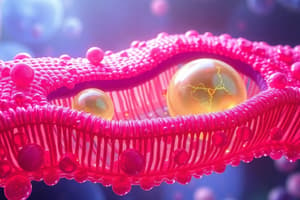Podcast
Questions and Answers
What is one of the primary functions of Cell Adhesion Molecules (CAMs)?
What is one of the primary functions of Cell Adhesion Molecules (CAMs)?
- Creation of the extracellular matrix
- Facilitation of cell migration (correct)
- Degradation of cellular waste
- Regulation of protein synthesis
What type of adhesion involves direct contact between cells?
What type of adhesion involves direct contact between cells?
- Signal Transduction Adhesion
- Cell-Matrix Adhesion
- Indirect Contact Adhesion
- Cell-Cell Adhesion (correct)
Which of the following is NOT a function of CAMs?
Which of the following is NOT a function of CAMs?
- Protein degradation (correct)
- Communication
- Structural integrity
- External sensing
Which component of the plasma membrane influences the fluid state of the membrane?
Which component of the plasma membrane influences the fluid state of the membrane?
What is a key characteristic of cell junctions in relation to their shape?
What is a key characteristic of cell junctions in relation to their shape?
What do adhesion molecules primarily mediate in cellular interactions?
What do adhesion molecules primarily mediate in cellular interactions?
Which one of the following is an aspect of signal transduction in cell membranes?
Which one of the following is an aspect of signal transduction in cell membranes?
What is a critical role of the extracellular matrix?
What is a critical role of the extracellular matrix?
Flashcards are hidden until you start studying
Study Notes
Objectives of Lecture
- Review membrane structures and their role in plasma membrane function.
- Explain the fluid state of membranes and lipid/protein movements.
- Summarize the functions of membrane proteins.
- Compare small and large molecule movements across plasma membrane.
- Identify different adhesion molecules in cells.
- Summarize components involved in signal transduction.
- Describe functions of extracellular matrix components.
- Review types of signaling complexes.
Nature and Composition of Plasma Membrane
- Composed of a mosaic of lipids, proteins, and carbohydrates.
- Structure supports various membrane functions, such as transport and communication.
Functions and Activities of Cell Membrane
Cell Adhesion
- Mediated by Cell Adhesion Molecules (CAMs).
- Includes direct cell-cell adhesion and cell-matrix adhesion.
- Connections can be direct or indirect.
Roles of CAMs
- Structural integrity: Maintains the shape and resilience of cells.
- External sensing: Helps cells respond to their environment.
- Migration: Facilitates movement of cells during development and healing.
- Regulation of transport: Controls the movement of substances in and out of cells.
- Communication: Enables signaling between cells.
Cell Junctions
- Critical factors: Shape and extent of contact between cells.
- Types of junctions can vary in form (e.g., punctate areas called maculae).
Extracellular Matrix (ECM)
- Composed of proteins and polysaccharides, provides structural support.
- Important for tissue integrity and cell signaling.
- Involved in cell adhesion and the formation of signaling complexes.
Studying That Suits You
Use AI to generate personalized quizzes and flashcards to suit your learning preferences.




